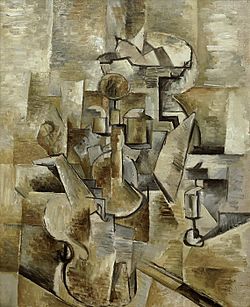Cubism
(1907-1915)
- pioneered by Georges Braque and Pablo Picasso
- People and objects are analyzed, distorted, broken up and reassembled in an abstracted form —instead of depicting from one viewpoint, the artist depicts the subject from a multitude of viewpoints (from above, side, front) to the extent the subject is almost unrecognizable.
- No illusionistic depth, every perspective appears on the same plane
- reduces objects and people to geometric shapes or cubes
- revolutionized European painting and sculpture, has been considered as the most radical break with traditional models of representation.
- abandoned perspective, which artists had used to order space since the Renaissance. And it turned away from the realistic modeling of figures and towards a system of representing bodies in space that employed small, tilted planes, set in a shallow space.
- Over time, Picasso and Braque also moved towards open form - they pierced the bodies of their figures, let the space flow through them, and blended background into foreground. This can be seen as a response to the changing experience of space and time in the modern world and the fragmentation of modern society.
Violin and Candlestick by Georges Braque (1910) Quarry Bibémus by Paul Cézanne
http://en.wikipedia.com
http://www.artyfactory.com/
http://www.arthistoryarchive.com/








